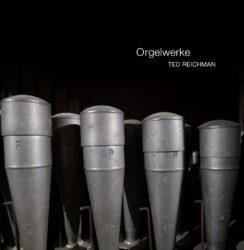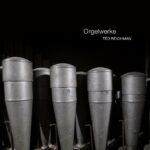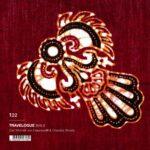TED REICHMAN – ORGELWERKE
Over the years, the church organ has become quite a popular instrument in experimental music settings. No real surprise, knowing the extreme dynamics the instrument has: it can go from whispering silence to intimidating thunder within seconds. And its natural habitat, a reverberating church, always adds an extra dimension to the experience.
But for his Orgelwerke (Organ Works) Ted Reichman took a different approach to the instrument. Finding ‘a pile of rare organ vinyl in a library’s discard box, […] he digitized them, turning them into loops and gestures, then reshaped them with tape, broken amplifiers, and analogue echo boxes.’
And you can simply trust a composer who studied experimental music and ethnomusicology with people like Alvin Lucier and Anthony Braxton to come up with something interesting!
But at the same time, this music does not sound like a usual church organ recording. The source is altered and modified to a different sonic entity, even if it still has its recognizable roots in the original instrument. In a fascinating way, these loops and soundscapes become ‘non-electronic electronic’ music.
The original recordings are looped into drones, but not the minimalist kind of drones: there is quite a lot happening here. The twelve-minute closing track Geisterorchester (Ghost Orchestra), especially, unleashes the full power a church organ is capable of, while also including the original sounds of a lightly scratched vinyl recording.
This is not exactly ‘ambient’ music: it requires active attention to be fully appreciated. So, perhaps, best file it under ‘power ambient’ – because it works best when played LOUD.
Orgelwerke is a download-only release; there is no physical edition.
CM VON HAUSWOLFF & CHANDRA SHUKLA – TRAVELOGUE (BALI)
Travelogue (Bali) is the second release in a series of ‘collected international audio diaries’ presented by Carl Michael Von Hauswolff and Chandra Shukla, the follow-up to 2020’s Travelogue (Nepal).
‘The premise is quite simple: the two meet at a mutually agreed upon destination along with the facilitation of something to record audio of these experiences on.’
This time, all sound sources are recorded in various locations in Bali: beaches, temples, markets, forests, mountains, etc. etc.
But beware: this is not exactly the kind of archival recording to preserve a specific cultural environment. The recordings are used as source material to create sonic sculptures rather detached from the original culture. In fact, they are actively morphed into quite an otherworldly trip.
The album kicks in rather relentlessly with a sonic modification of the Sanghyang – a traditional sacred Balinese dance, based on the premise that an unseen force enters the body of an entranced performer. You can almost literally feel that in the Kecak chanting, and even more so with the ghostly modifications of von Hauswolff and Shukla.
The following tracks are somewhat more ‘environmental ambient’, but the atmosphere remains mysterious and brooding. After three instrumental tracks, a mysterious vocal chant is reintroduced. It’s unclear what this chant is about (except for Bali residents, I assume). When the album finally concludes, it may leave you wondering what exactly you were listening to.
Bali’s nature feels like paradise, I know. But if I hadn’t seen that with my own eyes, I would hesitate to visit the island based on these soundscapes. And this is definitely meant as a compliment to these soundscapes by von Hauswolff and Shukla.




